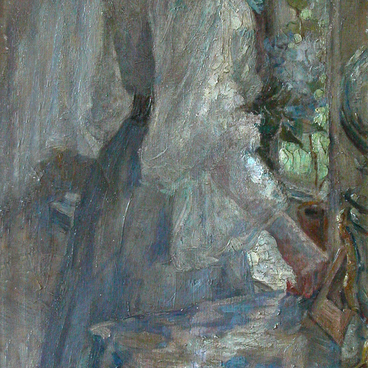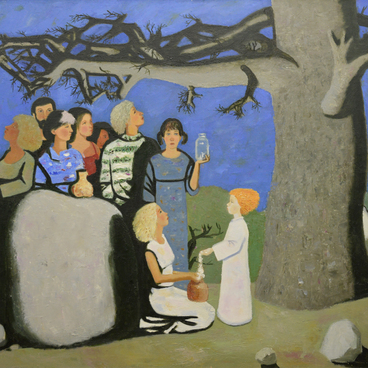The tendency for stylization manifested itself in the Soviet visual art in the 1970s and the 1980s. The foreign art in the frames of realistic art was in a focus of the Soviet artists’ interests.
The still lifes of old masters with their contemplativeness, analytical attention to each detail of the world were so different from the modern world full of contradictions and disharmony, that they attracted the painters’ attention.
The Still Life with a Kettle by Valentin Korshunov is a very delicate reflection of the Soviet everyday life in the philosophical presentation. Korshunov is a remarkable still life artist. Korshunov took interest in this genre during his studies at the Sverdlovsk Art College. One of his teachers Fyodor Shmelyov, who was a student of famous Ilya Mashkov, let the gifted student set the still lifes for the student practice.
At first the Trans-Uralian bread, peasants’ everyday objects, modern everyday life and old objects were the main motifs in Korshunov’s works. In the painter’s still lifes one could see the realistic reflection of the objects and their texture. However, the subjects of the paintings were more corresponding to what was important in the art of social realism.
In the last third of the 20th century the museum spree with its heightened interest in Renaissance art and Old European art touched the provincial Trans-Uralian art as well. Valentin Korshunov’s still lifes can be described in that context. Hardly any other Kugran painter ever paid so much attention to the value of modern everyday objects. With the seeming prosaicism of such still lifes, the life philosophy of their author is seen through them as well as poetization of ordinary life.
The objects in the exhibited still life are habitual for an artist studio. They are electrical appliances such as an old rusty rangette and a transistor helping the painter to set his heart on a needed vibe. The still life is completed with the simple dishes and a packet of tea with three lumps of sugar.
In the Old Masters’ still lifes the emphasis was placed to the symbolism of objects. In spite of the material nature of the depicted objects, they all had a sacral meaning (lemon as a symbol of unslaked thirst, nuts in the nutshell as a soul tied into the wicked thoughts, variety of expensive utensils as the frailty of life). In Korshunov’s still life, which is so close to the Netherlandish painters in its artistic approach, there’s no sacral meaning, but aspiration to draw the viewer’s attention to the importance and self-worth of objects ‘living’ with humans. This is why the atmosphere of almost museum silence giving the viewer a chance to contemplate on the ordinary things and life can be seen at the painting.
The still lifes of old masters with their contemplativeness, analytical attention to each detail of the world were so different from the modern world full of contradictions and disharmony, that they attracted the painters’ attention.
The Still Life with a Kettle by Valentin Korshunov is a very delicate reflection of the Soviet everyday life in the philosophical presentation. Korshunov is a remarkable still life artist. Korshunov took interest in this genre during his studies at the Sverdlovsk Art College. One of his teachers Fyodor Shmelyov, who was a student of famous Ilya Mashkov, let the gifted student set the still lifes for the student practice.
At first the Trans-Uralian bread, peasants’ everyday objects, modern everyday life and old objects were the main motifs in Korshunov’s works. In the painter’s still lifes one could see the realistic reflection of the objects and their texture. However, the subjects of the paintings were more corresponding to what was important in the art of social realism.
In the last third of the 20th century the museum spree with its heightened interest in Renaissance art and Old European art touched the provincial Trans-Uralian art as well. Valentin Korshunov’s still lifes can be described in that context. Hardly any other Kugran painter ever paid so much attention to the value of modern everyday objects. With the seeming prosaicism of such still lifes, the life philosophy of their author is seen through them as well as poetization of ordinary life.
The objects in the exhibited still life are habitual for an artist studio. They are electrical appliances such as an old rusty rangette and a transistor helping the painter to set his heart on a needed vibe. The still life is completed with the simple dishes and a packet of tea with three lumps of sugar.
In the Old Masters’ still lifes the emphasis was placed to the symbolism of objects. In spite of the material nature of the depicted objects, they all had a sacral meaning (lemon as a symbol of unslaked thirst, nuts in the nutshell as a soul tied into the wicked thoughts, variety of expensive utensils as the frailty of life). In Korshunov’s still life, which is so close to the Netherlandish painters in its artistic approach, there’s no sacral meaning, but aspiration to draw the viewer’s attention to the importance and self-worth of objects ‘living’ with humans. This is why the atmosphere of almost museum silence giving the viewer a chance to contemplate on the ordinary things and life can be seen at the painting.


